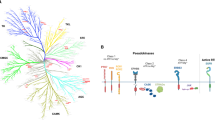Abstract.
Ras GTPases mediate a wide variety of cellular processes by converting a multitude of extracellular stimuli into specific biological responses including proliferation, differentiation and survival. In mammalian cells, three ras genes encode four Ras isoforms (H-Ras, K-Ras4A, K-Ras4B and N-Ras) that are highly homologous but functionally distinct. Differences between the isoforms, including their post-translational modifications and intracellular sorting, mean that Ras has emerged as an important model system of compartmentalised signalling and membrane biology. Ras isoforms in different subcellular locations are proposed to recruit distinct upstream and downstream accessory proteins and activate multiple signalling pathways. Here, we summarise data relating to isoform-specific signalling, its role in disease and the mechanisms promoting compartmentalised signalling. Further understanding of this field will reveal the role of Ras signalling in development, cellular homeostasis and cancer and may suggest new therapeutic approaches.
Similar content being viewed by others
Author information
Authors and Affiliations
Corresponding author
Additional information
Received 16 March 2007; received after revision 29 May 2007; accepted 15 June 2007
Rights and permissions
About this article
Cite this article
Omerovic, J., Laude, A.J. & Prior, I.A. Ras proteins: paradigms for compartmentalised and isoform-specific signalling. Cell. Mol. Life Sci. 64, 2575 (2007). https://doi.org/10.1007/s00018-007-7133-8
Published:
DOI: https://doi.org/10.1007/s00018-007-7133-8




